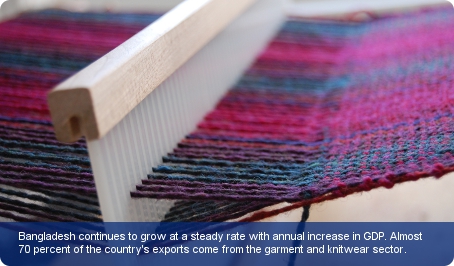Find a business in Bangladesh

Bangladesh has a GNI per capita of US$840 (2012). Despite political instability and the country’s vulnerability to monsoon flooding (in 1998 over 60% of its landmass was devastated by floods), Bangladesh continues to grow steadily with annual increases in GDP ranging from 4% to 5% since the 1970s. GDP growth per annum 2008-12 was recorded at 6.2%. This high growth was driven by strong exports and investment due to free-market policies, privatisation of state-owned enterprises, and banking reform instigated by successive governments from the mid-1990s.
The services sector only makes up 53% of GDP with agriculture (including forestry and fisheries) accounting for 19%. Although long-term economic policy has attempted to create an industrial and technological base to alleviate poverty, natural disasters, such as severe flooding, have often hampered this development.
| GDP by Sector (2008) |

Bangladesh does have huge reserves of natural gas (estimate at 400 billion cubic metres in January 2011) and some coal, as well as small reserves of limestone, china clay, and coal. But the country lacks metallic material reserves.
Manufacturing contributes 18% to Bangladesh’s GDP (2008), thanks largely to cotton textiles, jute, garments, tea processing, newsprint paper, cement, chemical fertilizer, light engineering and pharmaceuticals. Textiles and pharmaceuticals are some of the key export-oriented industries. Almost 70% of the country’s exports come from the garment and knitwear sector supported by jute, leather and frozen seafood. Approximately 50% of exports go the US and European countries.
| Consumer Price Inflation |

Bangladesh is ranked 122nd out of 183 in the Word Banks ‘Doing Business 2012’ study. English is spoken in urban areas and the country ranks highly in terms of investor protection sitting higher than its South Asian counterparts. These rankings measure the conduciveness of a regulatory regime in starting and operating a business.
| Real Growth in GDP |

There are 240,000 km of roads within Bangladesh, 10% of which are paved; these roads are vulnerable to damage from floods. Bangladesh contains 5,000–8,000 km of navigable waterway, depending on the extent of flooding, and a well-developed water transport network, carrying more than 30% of domestic freight. The main ports are Chittagong and Mongla, Chittagong dealing with the bulk of foreign trade. Zia International Airport, the main international gateway, is located 19 km north of the capital Dhaka.



